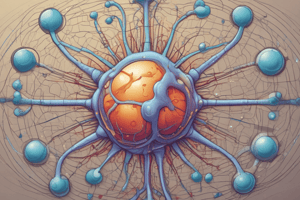Podcast
Questions and Answers
What does an agonist do?
What does an agonist do?
- Creates more receptor sites
- Activates a receptor site (correct)
- Blocks a receptor site
- Destroys a receptor site
What is the primary function of an antagonist?
What is the primary function of an antagonist?
- To prolong a biological response
- To amplify a biological response
- To initiate a biological response
- To block a biological response (correct)
Which of the following best describes an agonist's action?
Which of the following best describes an agonist's action?
- Mimicking the effects of a neurotransmitter (correct)
- Neutralizing stomach acid
- Reducing inflammation
- Inhibiting the production of enzymes
An antagonist prevents a response by doing what?
An antagonist prevents a response by doing what?
What is a key difference between an agonist and an antagonist?
What is a key difference between an agonist and an antagonist?
Which of these describes an agonist's interaction with a receptor?
Which of these describes an agonist's interaction with a receptor?
What term describes a substance that blocks the action of an agonist?
What term describes a substance that blocks the action of an agonist?
When an antagonist binds to a receptor, what does it prevent?
When an antagonist binds to a receptor, what does it prevent?
What is the result of an agonist binding to its receptor?
What is the result of an agonist binding to its receptor?
What is a term to describe when a drug binds to a receptor and prevents other substances from producing a biological effect?
What is a term to describe when a drug binds to a receptor and prevents other substances from producing a biological effect?
Flashcards
Agonist
Agonist
A molecule that binds to a receptor and activates it, producing a biological response.
Antagonist
Antagonist
A molecule that binds to a receptor and blocks the action of an agonist, preventing a biological response.
Study Notes
- Agonists and antagonists are crucial concepts in pharmacology and physiology, relating to how drugs and endogenous molecules interact with receptors in the body.
- Receptors are proteins on cell surfaces or within cells that bind to specific molecules, triggering a cellular response.
Agonists
- Agonists are molecules (drugs, neurotransmitters, hormones) that bind to a receptor and activate it, producing a biological response.
- They have both affinity and efficacy.
- Affinity refers to the ability of a molecule to bind to a receptor.
- Efficacy refers to the ability of the molecule, once bound, to activate the receptor and produce a response.
- Agonists can be classified based on the magnitude of the response they produce: full agonists, partial agonists, and inverse agonists.
Full Agonists
- Full agonists produce the maximal possible response for that receptor in the system.
- They stabilize the receptor in its active state.
- Example: Morphine is a full agonist at the μ-opioid receptor, producing a strong analgesic effect.
Partial Agonists
- Partial agonists do not produce the maximal response, even when all receptors are occupied.
- They have efficacy lower than that of a full agonist.
- They may also act as antagonists in the presence of a full agonist by competing for receptor binding.
- Example: Buprenorphine is a partial agonist at the μ-opioid receptor; it provides analgesia but with a lower risk of respiratory depression compared to morphine.
Inverse Agonists
- Inverse agonists bind to a receptor and produce an effect opposite to that of a typical agonist.
- They stabilize the receptor in its inactive state, reducing any baseline activity the receptor might have.
- Example: Some antihistamines act as inverse agonists at histamine receptors, reducing histamine activity and alleviating allergy symptoms.
Antagonists
- Antagonists are molecules that bind to a receptor but do not activate it.
- They block the receptor, preventing agonists (endogenous or exogenous) from binding and exerting their effects.
- They have affinity but lack efficacy.
- Antagonists are classified based on their binding properties: competitive, non-competitive, and irreversible.
Competitive Antagonists
- Competitive antagonists bind reversibly to the same site as the agonist.
- They compete with the agonist for receptor binding.
- The effect of a competitive antagonist can be overcome by increasing the concentration of the agonist.
- This shifts the agonist dose-response curve to the right, increasing the EC50 (the concentration of agonist required to achieve 50% of the maximal response) but not affecting the maximal response.
- Example: Naloxone is a competitive antagonist at opioid receptors, used to reverse opioid overdose.
Non-Competitive Antagonists
- Non-competitive antagonists bind to a site different from the agonist binding site (allosteric site) or bind irreversibly to the same site.
- They reduce the maximal response that the agonist can achieve, regardless of the agonist concentration.
- They can decrease the receptor's affinity for the agonist or prevent the receptor from being activated.
- The agonist dose-response curve is shifted downward, reducing the maximal effect (Emax).
- Example: Ketamine at the NMDA receptor.
Irreversible Antagonists
- Irreversible antagonists bind permanently to the receptor, either to the active site or to an allosteric site.
- They form a stable, permanent bond (usually covalent), effectively reducing the number of receptors available for activation by the agonist.
- The effect is similar to that of non-competitive antagonists, reducing the maximal response of the agonist.
- The only way to overcome the effect of an irreversible antagonist is to synthesize new receptors.
- Example: Phenoxybenzamine, which binds irreversibly to α-adrenergic receptors
Studying That Suits You
Use AI to generate personalized quizzes and flashcards to suit your learning preferences.




